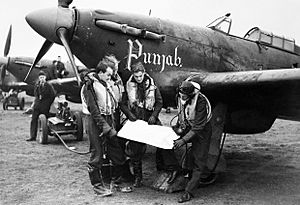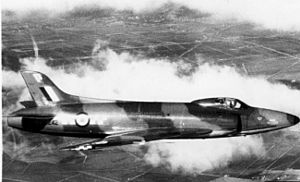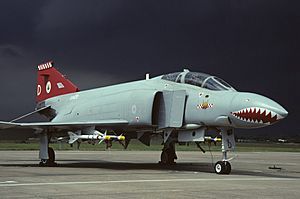No. 56 Squadron RAF facts for kids
Quick facts for kids No. 56 Squadron RAF |
|
|---|---|
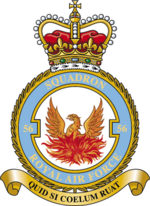
Squadron badge
|
|
| Active | 8 June 1916 – 1 April 1918 (RFC) 1 April 1918 – 22 January 1920 (RAF) 1 February 1920 – 23 September 1922 1 November 1922 – 31 March 1946 1 April 1946 – 31 July 1992 1 August 1992 – 18 April 2008 22 April 2008 – present |
| Country | |
| Branch | |
| Type | Flying squadron |
| Role | Operational Evaluation Unit |
| Part of | Air Warfare Centre |
| Home station | RAF Waddington |
| Nickname(s) | Punjab 'Firebirds' |
| Motto(s) | Quid si coelum ruat (Latin for 'What if heaven falls?') |
| Aircraft | Beechcraft Shadow R.1 Boeing RC-135W Airseeker R.1 |
| Battle honours |
|
| Insignia | |
| Squadron badge | A phoenix rising from fire, chosen to underline the squadron's ability to reappear intact regardless of the odds. Approved by King Edward VIII in July 1936. |
| Squadron roundel |  |
| Squadron codes | LR (Apr 1939 – Sep 1939) US (Sep 1939 – Apr 1946; 1947 – Dec 1950) ON (Apr 1946 – 1947) (Codes taken over from No. 124 Sqn) A–Z (Mar 1976 – July 1992) (Phantoms) AA–AZ (July 1992 – Apr 2008) (Tornados) |
No. 56 Squadron, also known as 'the Firebirds', is one of the oldest and most successful flying groups in the Royal Air Force. They earned many special awards for their bravery in both World War I and World War II. Their nickname, 'Firebirds', comes from the idea that they always manage to come back strong, no matter the challenge.
During World War I, the squadron had many top pilots, called 'aces'. These included James McCudden, Albert Ball, and Arthur Rhys-Davids. They became known for being very tough in the air. In World War II, they played a big part in the Battle of Britain. They also became skilled at attacking targets on the ground and at sea.
In the 1960s, No. 56 Squadron even had its own aerobatic display team. This team, also called 'The Firebirds', flew nine English Electric Lightning jets and performed at many airshows. Later, from 1976 to 1992, the squadron flew the McDonnell Douglas Phantom fighter jet.
Since 2008, No. 56 Squadron has been based at RAF Waddington in Lincolnshire. Today, they are a special unit that tests and evaluates new air command, control, intelligence, and surveillance systems for the RAF.
Contents
History of No. 56 Squadron
Forming and Fighting in World War I
No. 56 Squadron was created on June 8, 1916, at Gosport. It was part of the Royal Flying Corps (RFC). In March 1917, the squadron became the first RFC unit to get the brand new Royal Aircraft Factory S.E.5 fighter plane.
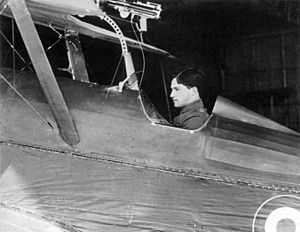
The squadron moved to France in April 1917. They quickly gained a reputation for being very skilled. Some German pilots even thought No. 56 Squadron was specifically formed to fight the famous German pilot, the Red Baron. On September 23, 1917, Lieutenant Arthur Rhys-Davids shot down and killed Werner Voss, a top German pilot, in an amazing air battle.
One of the squadron's first big victories was by Albert Ball on April 23, 1917. He shot down a German plane, his 32nd victory overall. Sadly, Ball was killed in action on May 7, 1917.
In June 1917, the squadron was called back to England. This was to help defend against German bombers that were attacking London. They later returned to France and fought in battles like Battle of Passchendaele and Cambrai. Captain James McCudden, who would become the squadron's highest-scoring pilot, joined in August 1917.
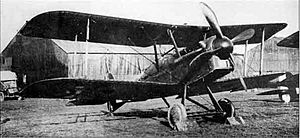
In March 1918, Germany launched a major attack. No. 56 Squadron helped by flying patrols and supporting ground troops. They also played a key role in the Battle of Amiens in August 1918. By the end of the war, No. 56 Squadron had achieved 427 victories in air combat.
Between the World Wars
After World War I, No. 56 Squadron moved back to Britain in February 1919. It was briefly disbanded but then reformed in Egypt in February 1920, flying Sopwith Snipe planes.
In September 1924, No. 56 Squadron started using a red and white checker pattern on their planes. This became their special way to identify themselves for many years. They flew different types of planes during this time, including the Gloster Grebe and Armstrong Whitworth Siskin.
The squadron settled at RAF North Weald in October 1927. In November 1928, they were allowed to use a phoenix as their emblem, with the motto Quid si coelum ruat (What if heaven falls?). This motto and emblem were officially approved by King Edward VIII in July 1936. Before World War II began, the squadron received its first Hawker Hurricane fighter planes in May 1938.
No. 56 Squadron in World War II
No. 56 Squadron's first experience of World War II was on September 6, 1939. While based at RAF North Weald, they were accidentally attacked by another British squadron. One pilot was sadly killed in this event.
The squadron, flying Hawker Hurricanes, first saw real combat during the Battle of France. They helped cover the Dunkirk evacuation, where many Allied soldiers were rescued. During the Battle of Britain in 1940, No. 56 Squadron was heavily involved in defending southern England. They shot down 59 enemy planes during this crucial battle.
In April 1941, the squadron gained its 'Punjab' nickname. This was because the Indian province of Punjab raised money to have their name linked to a fighter squadron.
In September 1941, No. 56 Squadron was the first unit to receive the Hawker Typhoon fighter. This plane was tricky at first, but the squadron helped make it a very effective fighter. Their role changed from defending against enemy attacks to becoming 'fighter-bombers'. They started attacking ground and sea targets using bombs and rockets.
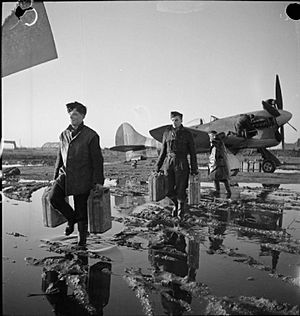
In June 1944, the squadron switched to the Hawker Tempest Mk.V. They were tasked with defending Britain from German V-1 flying bombs. The squadron shot down between 70 and 77 of these flying bombs. Later in the war, the 'Firebirds' moved to airfields in Belgium, the Netherlands, and Germany. By the end of World War II, No. 56 Squadron had shot down a total of 149 enemy aircraft.
Post-War and Jet Age (1946–1976)
After World War II, No. 56 Squadron reformed in April 1946. They received their first jet fighter, the Gloster Meteor F.3. In February 1954, they became the only squadron to fly the Supermarine Swift jet, but these planes were soon removed from service due to problems.
In May 1955, the squadron received the Hawker Hunter F.5. From 1958, they were based at RAF Wattisham for 35 years. Here, they often intercepted Russian Tupolev Tu-95 "Bear" aircraft that flew near UK airspace.
In December 1960, the squadron began flying the English Electric Lightning F.1A. In 1963, they formed their famous aerobatic display team, 'The Firebirds'. This team flew nine red and silver Lightnings. Sadly, the team was disbanded in 1964 after an accident during a practice display.

In May 1967, No. 56 (F) Squadron moved to RAF Akrotiri in Cyprus. They flew patrols over Cyprus during the conflicts there in 1974. In January 1975, the 'Firebirds' returned to RAF Wattisham.
The Phantom Years (1976–1992)
In March 1976, No. 56 (Fighter) Squadron began flying the McDonnell Douglas Phantom FGR.2. They returned to RAF Wattisham in July, sharing the base with another squadron. In October 1978, they were the first RAF squadron to use an aircraft painted in 'air superiority grey'.
In June 1979, a Phantom from No. 56 (F) Squadron recreated the first non-stop transatlantic flight of Alcock and Brown to celebrate its 60th anniversary. The pilot, Sqd. Ldr. A. J. N. Alcock, was the nephew of John Alcock, who made the original flight.
Both No. 56 (F) Squadron and No. 74 (F) Squadron, also based at Wattisham, participated in a special flypast for Queen Elizabeth II's birthday in June 1992. They flew 16 Phantoms in a diamond shape over Buckingham Palace. No. 56 (F) Squadron ended its operations at RAF Wattisham in July 1992.
From Tornados to Today's Role
On August 1, 1992, No. 56 (Fighter) Squadron became No. 56 (Reserve) Squadron. It moved to RAF Coningsby and became a training unit for pilots learning to fly the Tornado F.3 jet.
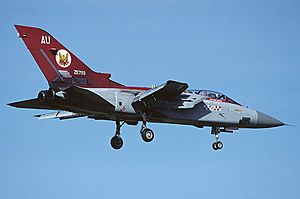
In March 2003, the squadron moved to RAF Leuchars in Fife. They continued to train Tornado F.3 crews until April 18, 2008, when the squadron was disbanded as part of a plan to introduce the Eurofighter Typhoon.
However, just a few days later, on April 22, 2008, the No. 56 Squadron name was transferred to the Air Warfare Centre at RAF Waddington. Here, the 'Firebirds' began a new role. They now test and evaluate advanced systems for the RAF, including airborne surveillance and command. They have worked with aircraft like the Boeing E-3D Sentry AEW.1 and Raytheon Sentinel R.1.
Since February 2018, the squadron is simply known as No. 56 Squadron, without the 'Reserve' part. Today, they continue to provide important testing and advice for the RAF's high-tech airborne systems.
Aircraft Operated by No. 56 Squadron
No. 56 Squadron has flown many different types of aircraft throughout its long history. Here are some of them:
- Royal Aircraft Factory B.E.2c (1916–1917)
- Royal Aircraft Factory S.E.5 (1917)
- Royal Aircraft Factory S.E.5a (1917–1919)
- Sopwith Snipe (1920–1924)
- Gloster Grebe Mk.II (1924–1927)
- Armstrong Whitworth Siskin Mk.IIIa (1927–1932)
- Bristol Bulldog Mk.IIa (1932–1936)
- Gloster Gauntlet Mk.II (1936–1937)
- Gloster Gladiator Mk.I (1937–1938)
- Hawker Hurricane Mk.I (1938–1941)
- Hawker Hurricane Mk.IIa/b (1941–1942)
- Hawker Typhoon Mk.Ia/b (1941–1944)
- Supermarine Spitfire Mk.IX (1944)
- Hawker Tempest Mk.V (1944–1946)
- Gloster Meteor F.3/F.4/F.8 (1946–1960)
- Supermarine Swift F.1/F.2 (1954–1955)
- Hawker Hunter F.5/F.6 (1955–1961)
- English Electric Lightning F.1A/F.3/F.6 (1960–1976)
- McDonnell Douglas Phantom FGR.2 (1976–1992)
- Panavia Tornado F.3 (1992–2008)
- Boeing E-3D Sentry AEW.1 (2008–2021)
- Raytheon Sentinel R.1 (2008–2021)
- Hawker Siddeley Nimrod R.1 (2008–2011)
- Hawker Beechcraft Shadow R.1 (2009–present)
- Boeing RC-135W Airseeker R.1 (2011–present)
Images for kids
See also
- List of Royal Air Force aircraft squadrons
- List of Battle of Britain airfields
- Battle of Britain


